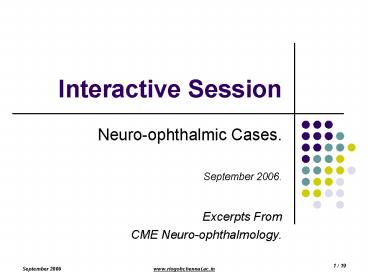Interactive Session - PowerPoint PPT Presentation
1 / 19
Title:
Interactive Session
Description:
Role of surgical management: if diplopia persists beond six months. September 2006 ... On LE lid elevation there is diplopia. No vasculopathic risk factors. ... – PowerPoint PPT presentation
Number of Views:244
Avg rating:3.0/5.0
Title: Interactive Session
1
Interactive Session
- Neuro-ophthalmic Cases.
- September 2006.
- Excerpts From
- CME Neuro-ophthalmology.
2
Case No. 1
- 30 yrs male
- Complaints
- sudden loss of vision in LE.
- O / E
- Neuro - cutaneous markers were found.
3
SLE Shows.
4
Other Findings
- Pupils- RAPD.
- Fundus shows the following picture-.
5
MRI Findings T1 And T2 Images
6
MRI Findings T1 And T2 Images
7
Discussion
- What is the diagnosis ?
- What are the ocular and neurological
manifestations? - What are the criteria to diagnose?
- How do you manage this case ?
- What is the DD ?
8
Answer To Case No. 01
- Diagnosis type 1 neurofibromatosis with optic
nerve Glioma. - Markers Lisch nodules, iris Mammilations, optic
nerve Glioma, retinal Astrocytoma, various
Meningiomas of brain. - Two of seven criteria café au lait spots,
neurofibromas, Axillary freckles, Lisch nodules,
optic nerve glioma, sphenoid wing dysplasia,
positive family history. - Management periodic observation. Surgical
management- when visual acuity is compromised. - DD optic nerve sheath Meningioma.
9
Case No. 02
- 40 yrs woman with complaints of double vision for
2 weeks. - No history of trauma.
- No vasculopathic risk factors.
- No other neurological deficit.
10
On Examination
- Face turned to right.
- RE Esotropic.
- RE abduction restricted.
- Other EOM full.
- Diplopia charting shows uncrossed diplopia with
maximum separation of eyes in dextroversion. - Fundus - normal.
11
Discussion
- What is the diagnosis ?
- What are the DD?
- What are the common causes?
- How do you investigate?
- What is DUANES syndrome?
- What are the syndromes associated with 6th nerve
palsy? - What is the role of surgical management?
12
Answer To Case No. 02
- Diagnosis right sided sixth nerve palsy.
- DD Duanes syndrome type 1.
- Causes DM, raised ICT, viral illness, others.
- Management complete neurological work up and
hematology. - Duanes syndrome is a restrictive squint caused
by co-contraction of medial and lateral Recti. - Other syndromes Gradenigo syndrome Godt-
Fredson syndrome Mobius syndrome Raymonds
syndrome Fovilles syndrome. - Role of surgical management if diplopia persists
beond six months.
13
Duanes Retraction Syndrome.
14
Case No. 03
- 28 yrs female.
- Complaints of
- Drooping of left UL - sudden in onset.
- On LE lid elevation there is diplopia.
- No vasculopathic risk factors.
- No other neurological problems.
15
On Examination
16
On Examination
- LE is divergent
- LE -EOM are restricted except abduction
- Pupil dilated
- Fundus normal
- Diplopia charting-crossed diplopia
- RE appears normal
17
Discussion
- What is the diagnosis?
- How do you approach ?
- What is the investigation of choice?
- How do you assess 4th nerve function in the
setting of complete 3rd nerve palsy ?
18
Answer To Case No. 03
- Diagnosis complete left sided third nerve palsy.
- Approach assess the level of lesion and
compliment with complete neurological workup. - Investigation of choice MRI.
- Assessment of 4th nerve
- Prompting to the patient to look down in
abduction gaze watch for intorsion.
19
- End of presentation.































